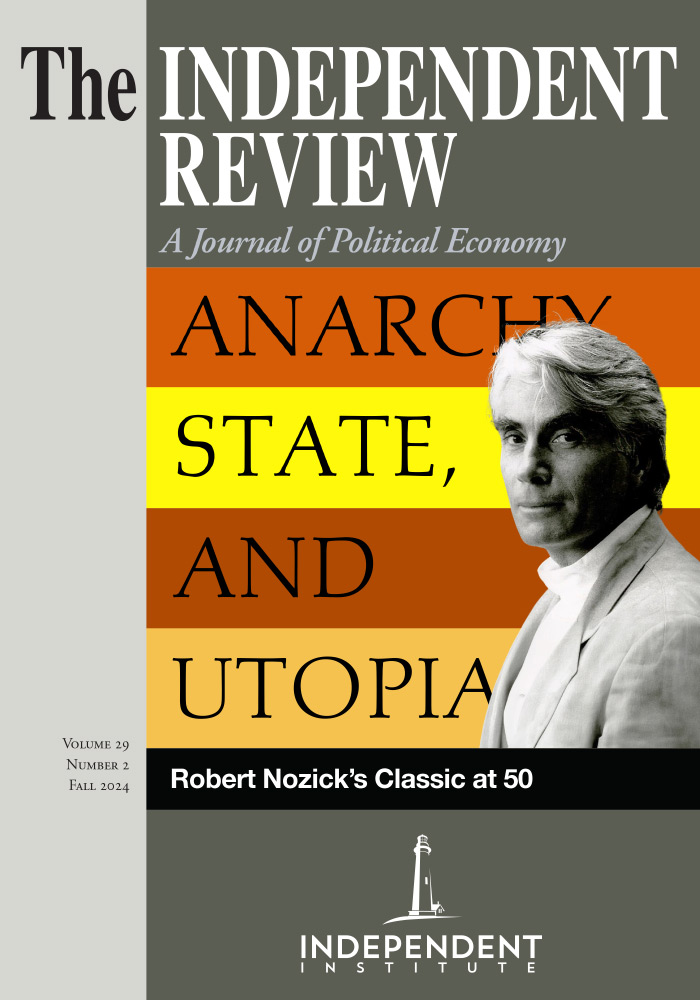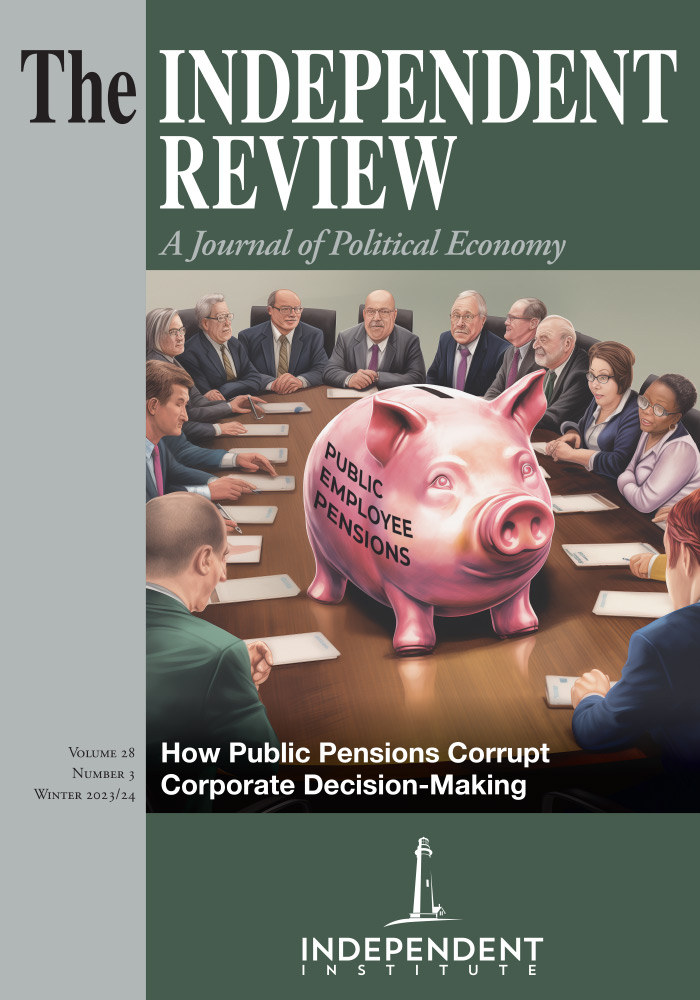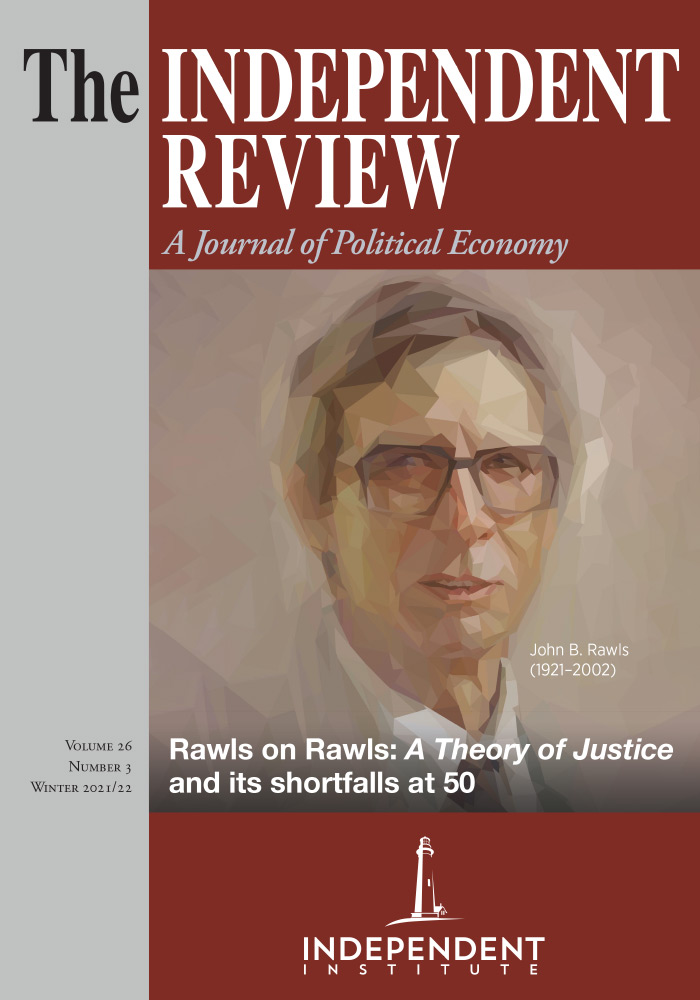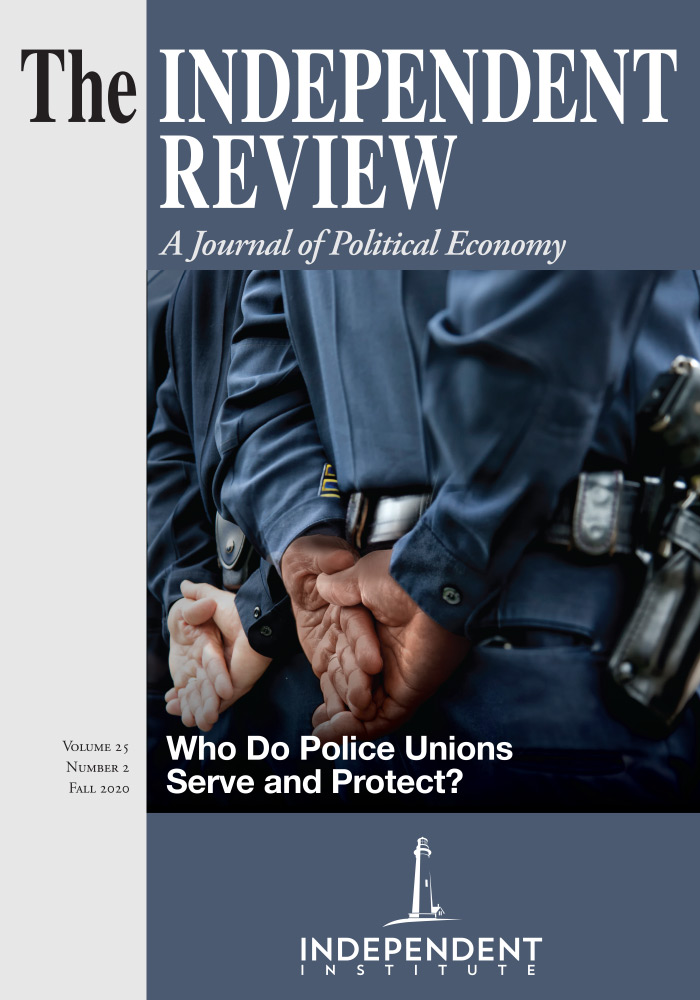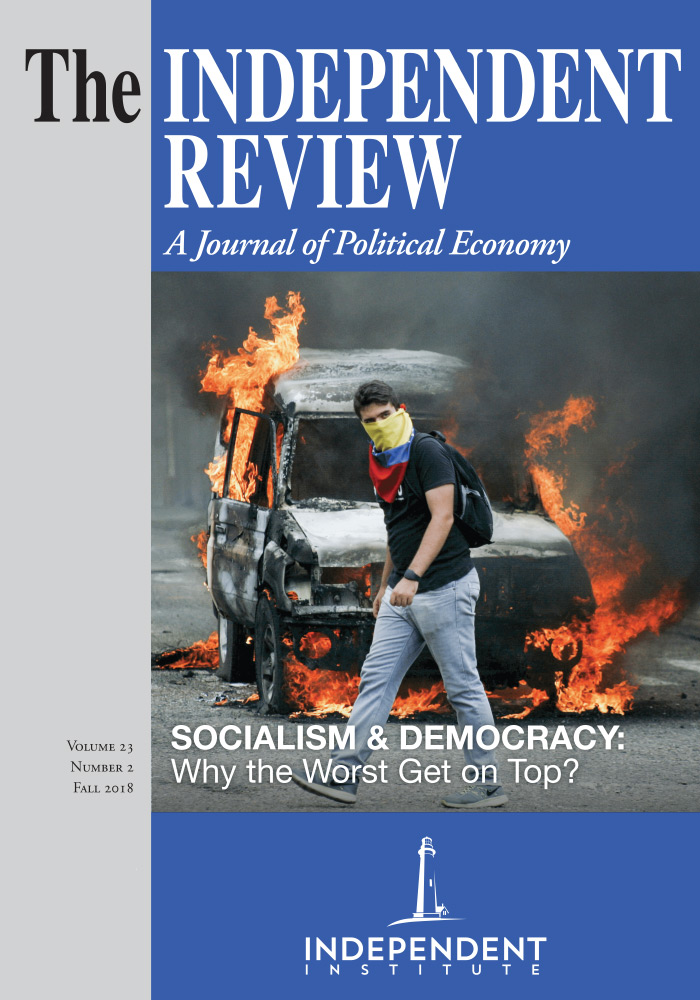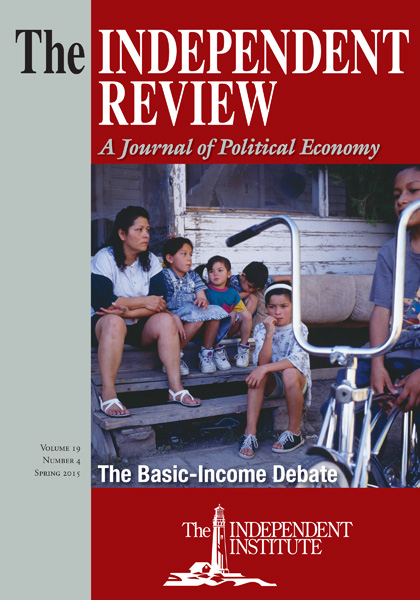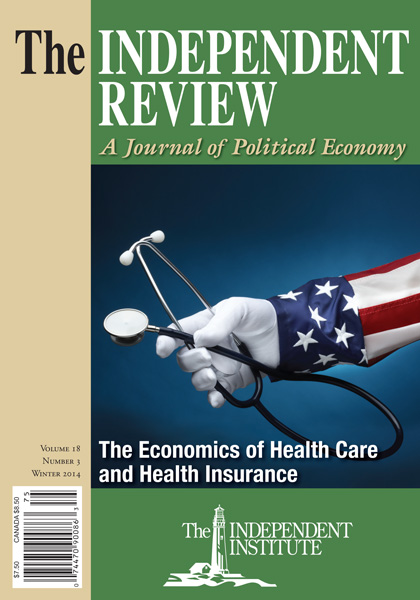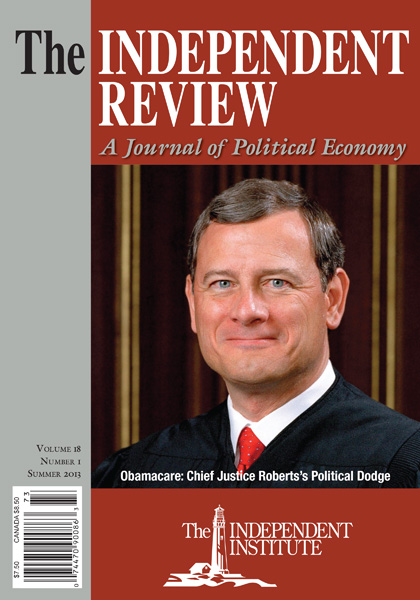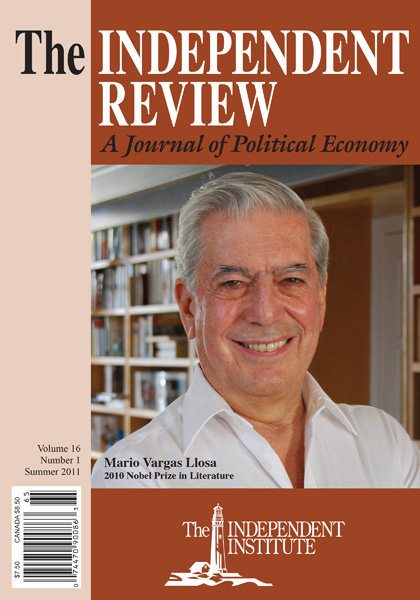The term social justice is a philosophical Rorschach test viewed by some people as the moral fairness of the system of rules and norms that govern society but viewed by others as an incoherent rationalization for coercion and wrongdoing. The Independent Review’s Summer 2019 symposium offers fresh insights on this vexing topic by relating social justice to ongoing debates in economics, history, philosophy, politics, public policy, religion, and the broader culture.
Article
We all hunger to live in a just world. Most of us work constantly, in ways great and small, to promote justice.
But what is justice? The classic definition—the “constant and perpetual will to render to each what is due him” (Justinian n.d.)—is a solid foundation on which to build. But what is social justice? At this point, there is considerable disagreement. For many, the term social justice is baffling and useless, with no real meaning. Most who use it argue that social justice is the moral fairness of the system of rules and norms that govern society. Do these rules work so that all persons get what is due to them as human beings and as members of the community? Shifting from the will of individuals in rendering justice to the outcome of the system of rules in achieving justice can be a dangerous leap. To some, it suggests that virtually every inequality arises because the rules of the game are unfair and that the state must intervene whenever there are unequal outcomes.
The dangers of this leap are the primary focus of the symposiumthat fills up the pages of this issue of The Independent Review. In this symposium, fourteen authors have accepted the Independent Institute’s challenge to “explore, reassess, and critique the concept of social justice—relating it to ongoing debates in economics, history, philosophy, politics, public policy, religion, and the broader culture.” We organized the symposium because many thinkers pondering “social justice” have reached for something great but have failed in their grasp. Because of this gap, the term social justice has acquired considerable baggage. For some people, it encapsulates the highest aspirations of everything that is right, but for others it embodies their darkest fears. Progressives often venerate the term, and it animates the core of their policy prescriptions, whereas classical liberals often see it as “inimical to the classical liberal tradition” (as Vincent Geloso and Philip Magness put it in their essay). The latter warn that “social justice” has been fashioned into a cudgel used by those pretending to the higher ground in their militant rent seeking. Thomas Sowell admonished that “social justice” is merely a fig leaf for wrongdoing: “Envy was once considered to be one of the seven deadly sins before it became one of the most admired virtues under its new name, ‘social justice’” (1999, 77).
Social justice is certainly a vexed topic. Has the term been so badly mangled by the conflicts over its use that it should be abandoned? Many classical liberals have become so wary of it that they think it should be avoided. Too many using the term have talked (or screamed) past each other. Can the term social justice be rescued?
Confronting these problems, our prize-winning essayist, James Otteson, argues that we should care about social justice, despite all its unavoidable definitional difficulties. In “Opting Out: A Defense of Social Justice,” Otteson begins by warning that social justice implies enforcement—that “the issue concerns not just differences of opinion about how resources should be allocated, what virtue requires, what public institutions we should have, or how people should be treated. Rather, the issue is that the use of the term social justice . . . entails either applying coercivemechanisms toenforce one viewover anotheror endorsing punishment for incorrect behaviors or outcomes.”
Otteson continues that much advocacy of social justice is compromised by its failure to distinguish between inequality arising from (1) luck or (2) “deliberate choice[s] that agents are entitled to make” and inequality arising from (3) choices made by people who “are not entitled to make” those choices (emphasis added). Social justice advocates often run these three categories together: “[S]omething of which I disapprove has happened or is the case; therefore, remedies are required. And if remedies are not voluntarily forthcoming, then ‘social justice’ demands it—justice being the preferred term not only because it connotes both gravity and certitude (even self-evidence) but also because it licenses coercive enforcement if necessary.”
As an alternative to confusion and coercion masquerading as fairness, Otteson draws on the insights of Adam Smith and other classical liberals:
Smith argues that our natural desire to better our own condition leads us to seek cooperation with others in mutually beneficial ways . . . [and that] this can happen only within a “well-governed society” . . . whose public institutions protect “the life and person of our neighbour,” each citizen’s “property and possessions,” and each citizen’s “personal rights, or what is due to him from the promises of others.” When those three pillars of justice are protected, I am forestalled from getting what I want from others by enslaving them, stealing from them, or defrauding them. Thus, my only recourse is to make offers of voluntary cooperation, which others are free to decline if they so choose.
Otteson extols Smithian justice, which “protects others’ opt-out option, which disciplines me to consider their interests, not just my own; and my own opt-out option disciplines them to consider my interests, not just theirs. . . . My need for your voluntary consent requires that in order to achieve my own goals I must consider your wishes, your desires and needs, and your values and obligations and constraints and that Imust therefore show you respect. My own opt-out option means you must show me respect as well. A society that protects Smithian ‘justice’ therefore requires and engenders mutual respect.”
Otteson concludes that it is fruitful to think about social justice as requiring the removal of formal restrictions placed on any individuals or groups that limit their ability to achieve a flourishing life as they themselves understand it. He endorses a “political and economic policy that rewards people for engaging in cooperative behavior and partnerships that provide benefit and value to others as well as to themselves—and that hence punishes or disincentivizes behavior that benefits one person or group at the expense of others.” He concludes that a commercial society constrained by protections of liberal negative justice encourages both increasing material prosperity and morally improved relations among increasingly many people.
A Consensus on Social Justice
The arguments of the remaining contributions have considerable overlap with Otteson’s essay and with each other. This is salutary because in approaching a subject as important as justice, it is imperative to begin with fundamental principles and to assess what has worked and what has failed. Synthesizing their thoughts is a daunting task because each has so much to say.
If there is a consensus among our contributors, it is that the term social justice can be rescued and rehabilitated only when it stands on legitimate principles—principles that recognize each person as unique, unrepeatable, worthy of dignity, and endowed with the ability and right to direct his or her own life without harming others, while also noble enough to care deeply for the well-being of others. When each person is seen as unique and worthy of dignity, humanity won’t be shattered into irreconcilably fragmented groups. If social justice is seen in this light, it involves working to assure that the norms, laws, and legislation of society free people to do what is good for themselves and good for others—not enabling some to impose their wills upon those with less power, but empowering everyone to flourish. This generally means not only working through political democracy, a market economy, and the organizations of civil society (especially the family) but also removing barriers that hinder the most vulnerable and those in danger of being forgotten or left behind.
The consensus includes a somber warning: even honest attempts to involve the state in redistributing resources to bring about more socially just outcomes can and often do rapidly decay into base rent seeking, so that resources and opportunities go to those who have political sway. The progression is even more rapid when the attempts to redistribute are less honest. Such interventions often undermine a free society and the progress it brings. As an example, free college tuition for everyone may sound worthwhile and generous, but it doesn’t take long to notice that the major beneficiaries would be rent-seeking college administrators and faculty members and that there might be better ways to make higher education more affordable to students with limited financial means.
The consensus also attacks unwarranted privilege. Capitalism, centered on voluntary exchange and widespread opportunity, is a pillar of true social justice, but crony capitalism is not.[1] A just system must do no harm before it can walk the extra mile.
This consensus is in stark contrast to themost destructive branches of themodern social justice movement, which envision the economy, society, and politics as zero-sum games or, worse, see society as locked into a civil war between groups of oppressors and groups of victims. They see conflict everywhere rather than cooperation. They proclaim that the rules allow only a few to thrive. This rising rancor about “social justice” sits uncomfortably beside the exceptional standards of living and improvements in health, life expectancy, education, and self-reported well-being in the modern world. Because modern markets are a positivesum game, material standards of living are at the highest level in human history and continue to rise. Absolute poverty is disappearing. The perverse reaction has been to turn a blind eye to success, ungratefully oblivious to how fortunate we are, and complain that some other person hasmore. Perhaps one of the greatest injustices of human history is that we now live the high life, standing on the shoulders of those who came before us and struggled in a worldmarked by brutal poverty. We have escaped their ubiquitous hardship in part because of their wise decisions, and we cannot help them, yet we pretend that we are the ones struggling in an unfair, unkind world. The “social justice” movement ignores these manifest, widespread gains and insists that the modern economy is one in which only a few players win because the deck is stacked. (Tell this to the owners of Sears and General Electric, but don’t expect the lucky customers of the firms that have displaced them to pay attention.)
Animating much of the symposium is an unsuccessful conversation between John Rawls in A Theory of Justice (1971) and Friedrich Hayek in The Mirage of Social Justice (1976). The authors take very seriously Hayek’s conclusion that “social justice” is a misguided, incoherent notion because there is no true morality to emergent outcomes that are unintended. However, they push Hayek and themselves to go the next step and explain how to respond to the broadening of the concept of social justice from mere monetary redistribution to wider questions about underlying institutions, privilege, and societal relationships.
New Thinking on Social Justice
After Otteson’s opening salvo comes the symposium’s harshest criticism of modern social justice ideas. In “Social Justice versus Western Justice,” Daniel Guerrière argues that most proponents of social justice equate justice with equality and aim at nothing less than reforming the “consciousness” of uncompassionate, irredeemable deplorables. The discovery, protection, and promotion of the uniqueness of the person is one of the great achievements of Western civilization. The ideals of modern social justice risk throwing this achievement away by unhuman means whose outcome is massive misery. Correctly grounded ideas of justice that are rooted in the ancient Greeks, Hebrews, and Romans suggest that pluralistic democratic capitalism is a better model of social justice.
In “Social Justice, Public Goods, and Rent Seeking in Narratives,” Vincent J. Geloso and Philip W. Magness are much more supportive of modern social justice approaches. They argue that classical liberals should be amenable to attempts to salvage part of the new social justice discourse because undeniable invisible forces at play have led to lesser outcomes for certain groups. Hindering “relational” equality is one way of erecting rent-preserving entry barriers for favored groups. Classical liberals must work to dismantle barriers to entry—formal and informal—for excluded groups. Geloso and Magness illustrate both the concept of “rent seeking in narratives” and the idea that cementing relational inequality may work against both minorities and majorities by examining racism toward black Americans in the nineteenth century and discrimination aimed at the French Canadian population of Quebec in Canada.
Jacob T. Levy notes in “Social Injustice and Spontaneous Orders” that classical liberals have self-consciously moved toward an embrace of social justice in Rawls’s sense and have adopted a wider range of concerns such as “identity” and “oppression.” Unfortunately, Levy points out, we are surrounded by many injustices—injustices that provide grounds for legitimate complaint—that cannot be remedied. “Social justice” has bitten off more than it can chew. We need to prioritize the mitigation and prevention of true injustices in our political-moral thinking rather than continue to exceed our grasp in reaching for unobtainable “social justice.”
In “Hayekian Social Justice,” Kevin Vallier determines that Rawlsian social justice is too radical and unreachable. Contractarian approaches that aim to reconstruct society from scratch are untenable. We need Hayekian humility when considering social reform because of our own fallibility and the cautionary track record of social engineering from the ground up. Piecemeal, marginal reform may be more reasonable. There may be an important role for a constrained state in assisting the disadvantaged—incrementally working to maximize average well-being with a utility floor—but not a massive state whose core mission is redistribution.
Continuing the critique of Rawls, Daniel J. D’Amico points out that there are significant “knowledge problems from behind the veil of ignorance.” The Rawlsian social justice framework implies that social outcomes are capable of being designed and strategically manipulated through democratic deliberation. However, comparative social science demonstrates a much broader swath of workable institutional types than the Rawlsian vision accommodates. D’Amico uses the case study of traditional Inuit society to discuss how there are simply too many substantial knowledge problems hiding behind the veil of ignorance.
James Stoner explains in “Civil Society and Social Justice: A Prospectus” that social justice needs to restore an Aristotelian and Thomistic anthropology without succumbing to the statist trap laid by Wilhelm Hegel. Social justice must recognize the basic individual rights out of which civil society developed (life, liberty, property, exchange, and communication). The state, the family, and civil society need to flourish in their own realms, without the state dominating all.
The next two essays identify two fundamental defects of modern social justice—one tied to its theory, the other to its practice. In “Social Justice, Economics, and the Implications of Nominalism,” R. Scott Smith shows that a key assumption of modern social justice is nominalism—the theory that only particular things exist, that there are no real universal, identical, shareable qualities. Smith argues that nominalism undermines justice and economic practice. By taking ethics as nominal, modern social justice theory reduces justice to power. In “The Mantle of Justice,” Adam Martin explains that the most fundamental pathology of modern social justice is “justice creep,” which expands the range of issues over which we are supposed to feel resentment. But “justice is a blunt moral instrument. . . . [W]hen dealing with complex, nuanced issues, it may consume valuable moral resources or even lead us to misdiagnose problems entirely.” According to Martin, either outcome is very worrying, especially with respect to issues of poverty and economic inequality. Resentment may get people “on the streets or into the voting booth,” but it doesn’t “equip [them] to deal with such issues in a constructive manner. . . . The mantle of justice is weighty.”
In “Social Justice: Intersecting Catholicism, Citizenship, and Capitalism,” John A. Moore argues that social justice “must encompass spiritual and civic elements that go well beyond a simple materialist response.” He agrees with Michael Novak that social justice is “the capacity to organize with others to accomplish ends that benefit the whole community” (Novak 2000, 13). True social justice emerges as a bottom-up “experience that encompasses an individual’s legal and social status in a society of citizens, all of whom possess rights and responsibilities, and where work is recognized as beneficial and dignified”—rather than a top-down experience where “the state rather than the individual takes responsibility for dispensing social justice.” Top-down social justice “lacks a soul.” It claims to have broadened the playing field in the search for justice, but it has instead only constricted the field.
Starting with a simple example of two people trading, Anthony Gill considers a definition of social justice that appeals to many—the idea that gains from trade between a buyer and a seller will be equal—in his essay “An Exchange Theory of Social Justice: A ‘Gains from Trade under Uncertainty’ Perspective.” Numerous problems immediately arise, including what price(s) should hold when preferences vary, the impact of uncertainty about costs and preferences, and the dynamic nature of competition. “Notions of social justice that are rooted in a particular equitable distribution chase a . . . benchmark that doesn’t exist or, at least, doesn’t last for long.”
In “Is Social Justice a Mirage?” Stefanie Haeffele and Virgil Henry Storr tackle this question in the symposium’s final essay. Hayek argues that social justice “has no real meaning within the context of a free society” and that “advancing reforms based on social justice will undermine a free society and progress.” He contends that the market is like “a game with rules of conduct as well as winners and losers,” and that although the outcomemay be unfortunate, it is not “just” or “unjust.” Haeffele and Storr argue that this view ignores a major criticism from modern social justice advocates. If the referees prefer some players over others, the game is rightly considered unjust.When the socioeconomic system favors powerful market and government actors, social injustices can occur, and it is appropriate and even obligatory to consider reforms that limit favoritism.
Our authors have spent untold hours and years wrestling with ideas about the nature of social justice, looking for inspiration, and building on the ideas of modern giants such as Adam Smith, John Rawls, F. A. Hayek, and Michael Novak as well as on the ideas of ancient thinkers from Aristotle to Jesus of Nazareth. Their essays thus provide much light for marking out surer paths toward greater social justice.
Notes
[1] See the symposium on crony capitalism in the winter 2019 issue of The Independent Review.
References
Hayek, F. A. 1976. The Mirage of Social Justice. Vol. 2 of Law, Legislation, and Liberty: A New Statement of the Liberal Principles of Justice and Political Economy. Chicago: University of Chicago Press.
Justinian. n.d. Quotations from Corpus juris civilis. Wikiquote. Accessed February 26, 2019.
Novak, Michael. 2000. Defining Social Justice. First Things, December. Accessed February 26, 2019.
Rawls, John. 1971. A Theory of Justice. Cambridge, MA: Harvard University Press.
Sowell, Thomas. 1999. The Quest for Cosmic Justice. New York: Free Press.
| Other Independent Review articles by Robert M. Whaples | ||
| Spring 2025 | Millennials, Gen Zs, Capitalism, Socialism, and Confusion | |
| Spring 2025 | Not Stolen: The Truth about European Colonialism in the New World | |
| Spring 2025 | Green Breakdown: The Coming Renewable Energy Failure | |
| [View All (106)] | ||





